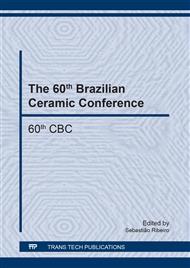p.175
p.180
p.185
p.191
p.196
p.202
p.207
p.212
p.218
Characterisation of Geopolymer Cements Obtained from Different Sources of Metakaolin
Abstract:
In the present study metakaolin and clay brick waste (CBW) were used as a source of silica and alumina along with precursors aiming to obtain geopolymer cements, which were characterised via scanning electron microscopy (SEM) and X-ray diffraction (XRD). The CBW was obtained from rejected clay brick industrial manufacturing process. The precursors were activated by using of 5.0, 10.0 and 15.0 [mol.L-1] KOH solutions, which was added to K2SiO3 solution at 1:1 weight ratio. To obtain the geopolymer cements the weight ratio of precursor and activators were changed at levels of 0.6, 1.0 and 1.4. The samples were prepared and cured at room temperature for 7 days. The geopolymer cement obtained from metakaolin at 15 mol.L-1 level of KOH concentration and KOH/K2SiO3 ratio of 1:1.4 provided the best cement which can be estimated by the largest reduction and dissolution of crystalline phases in the activation reaction.
Info:
Periodical:
Pages:
196-201
Citation:
Online since:
January 2018
Price:
Сopyright:
© 2018 Trans Tech Publications Ltd. All Rights Reserved
Share:
Citation:


